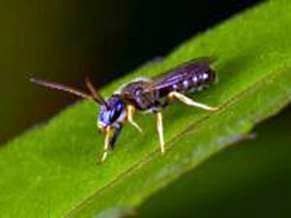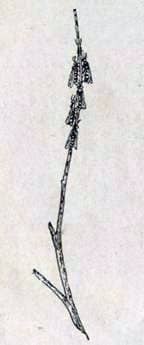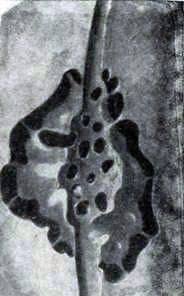
You could talk about all this for a long time. But it is better to turn to those forms in which you can find the beginnings of a social way of life.
Some species of bees in places with good conditions for nesting have their nests close to each other. Although these insects are completely harmless, whether they build their nests alone or several in one place, with the increase in the size of the settlement, their courage seems to increase. They are defended, if necessary, and swarm attack the one who hinders them. Some species in autumn search for earth holes and overwinter in them by large communities. Let these gatherings are conditioned in such cases by favorable nesting conditions or tempting shelter – in this you can still see a certain desire for a social way of life.

Fig. 109. Six males of a single bee from the genus of halicts, which in bad weather, as well as for spending the night, gather at the same place of the dried stalk. (Real size.)
Perhaps, in its original form, the social instinct is manifested only in the desire of insects to simply stay together – without a definite purpose. In Fig. 109 depicts the upper end of a dried flower stalk, on which several males of one species of small solitary bees gathered for the night. During the day, in good weather, they fly out in all directions, but as soon as the sky is tightened by rain clouds, and every evening at dusk they gather in the same place for a joint rest.
This stalk is no different from the surrounding countless exactly the same stems. Bees do not find a warm shelter on it – in the crown of any flower they would be better protected from the cold than on this stalk, swaying from the wind. They do not find on it either protection from rain or food, and the females of their species live somewhere else. They have to settle for their own society here, and, apparently, they feel the need for it.
This, of course, can not be called an ongoing community. But if such a social instinct awakens in the female individuals and conditions their activity, then it can lead to the formation of a community. We know of one species of bees that dig a mine in clay soil and from the material at their disposal model a cave with an elegant clay honeycomb. In the cells of this honeycomb, the bee lays eggs. She takes care of the growing larvae and feeds them, protects the nest and lives until they become older bees.

Fig. 110. The clay honeycomb honeycomb built into the clay wall. The inlet shaft and cavity of the socket are opened in the front. To the left one cell is hacked. (Decreased by half.)
At one species close to her, the young bees leaving the cells do not scatter in different directions, but remain in place. They continue to rebuild the honeycomb they have started, lay their eggs in the same nest and all care for the brood. The one who brings the food, gives it to the whole family, and not just his own offspring. Only the onset of autumn violates this coexistence. Next spring, each female starts all over again: laying a nest alone, she becomes the founder of a small bee state.
To another species of bees – the galction of marginalus – the name “single bee” is hardly suitable. Here the founder of the nest reaches the age of four to five years, as well as the uterus of the honey bee. Throughout her life she remains faithful to her nest. From year to year, the number of her daughters grows, which build on the same settlement, gradually increasing it. This is how a large family develops, numbering more than a hundred members – entirely females, which, however, almost all remain not fruitful and devote themselves to obtaining food, caring for brood and building honeycombs.
The founder of the nest is released from this type of occupation, remains at home and becomes the motherhood of the family. By the end of this many-year cycle, males appear, females mate with them and base new families, and the old colony breaks up.
If in the halictus of marginalus the infertile females differ from the uterus only in that their ovaries do not reach full maturation, then in another species of this diverse kind of galict, females are much smaller and therefore already outwardly resemble working bees.
Как несут пчелы пыльцу. Торт идеалы с медом.
Breeds of bees